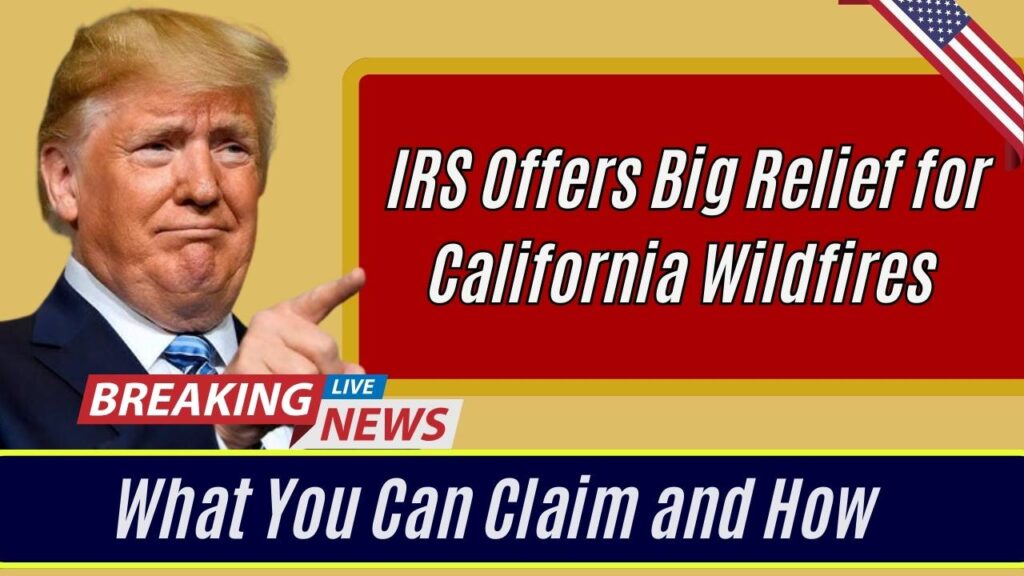IRS Offers Big Relief for California Wildfires – The devastating wildfires that swept through Southern California in early 2025 left thousands of families and businesses grappling with emotional and financial loss. Recognizing the immense challenges faced by these communities, the Internal Revenue Service (IRS) has implemented an extensive tax relief package to help ease the burden and support the recovery journey of affected individuals. This article provides a comprehensive and easy-to-follow guide on what tax relief is available, how to qualify, and the best practices for filing claims effectively.

In addition to tax extensions and deductions, affected taxpayers may be eligible for employment credits, penalty waivers, and even opportunities to amend past tax filings for greater benefits. Understanding these provisions can make a significant difference in how quickly households and business owners get back on their feet.
IRS Offers Big Relief for California Wildfires
| Topic | Details |
|---|---|
| Disaster Declaration | FEMA Disaster Number: 4856-DR |
| Extended Tax Deadline | October 15, 2025 for affected individuals and businesses |
| Eligible Deductions | Uninsured or unreimbursed losses to personal property, homes, and vehicles |
| Claiming Prior Year Losses | Option to claim disaster-related losses on 2024 tax return for potential larger refund |
| Tax-Free Relief Payments | Qualified disaster relief payments are excluded from gross income |
| Required Forms | Form 4684 (Casualties and Thefts), Form 1040-X (Amended U.S. Individual Income Tax Return) |
| Documentation Needed | Photos of damage, repair receipts, insurance claims, and original purchase records |
| Additional Business Relief | Employers may postpone payroll tax deposits, claim retention credits, and write off damages to business assets |
| Beware of Scams | IRS will never call, text, or email to ask for personal info—report scams immediately |
| Disaster Hotline | Call 1-866-562-5227 for IRS assistance related to wildfire relief |
| Official IRS Resource | IRS Disaster Assistance and Emergency Relief |
The IRS’s response to the 2025 California wildfires is one of the most robust disaster relief efforts in recent history. By offering deadline extensions, deductions, and financial exclusions, the agency is helping thousands of families and businesses rebuild their lives. Whether you’re a homeowner, renter, or employer, understanding your rights and following these steps can help you access the full range of support available.
Understanding IRS Tax Relief for California Wildfire Victims
Following the wildfires that ignited on January 7, 2025, the IRS swiftly designated multiple regions of California as federally declared disaster zones. This move unlocks a series of tax advantages intended to soften the blow of property loss, business interruption, and personal displacement.
Individuals and businesses within the FEMA-declared disaster areas can now take advantage of deferred filing deadlines, relaxed documentation requirements, and deductions that would otherwise be unavailable. For many residents who lost homes, vehicles, and irreplaceable personal belongings, these benefits can be life-changing.
1. Extended Tax Filing and Payment Deadlines
All eligible taxpayers in disaster zones have until October 15, 2025, to file federal income tax returns and pay any taxes originally due between January 7 and October 15. This includes 2024 returns, 2025 quarterly estimated taxes, and certain business filings such as payroll or excise taxes. No separate application is needed to claim this extension—it applies automatically if your IRS record shows an address within the disaster zone.
2. Casualty Loss Deductions
A casualty loss occurs when your property is damaged or destroyed due to sudden, unexpected events like a wildfire. These losses may be claimed as itemized deductions if they are not covered by insurance. Common items eligible for deduction include:
- Damage to your primary residence or rental property
- Loss of vehicles and personal belongings
- Cleanup and repair costs not reimbursed
Use Form 4684 and consult Publication 547 to ensure your documentation meets IRS standards. Be thorough with receipts and estimates to maximize your deduction.
3. Claiming Losses on Prior Year Returns
One often-overlooked benefit is the ability to deduct current-year disaster losses on your prior year’s tax return. This allows for quicker financial relief, especially helpful if your 2024 income was higher and therefore your tax liability was greater. To do this, file an amended return using Form 1040-X and attach Form 4684 to support your claim.
This option can lead to a larger tax refund and may offer quicker access to cash during recovery.
4. Exclusion of Qualified Wildfire Relief Payments
Certain payments related to disaster recovery are excluded from taxable income. These include:
- Government payments for housing, food, and clothing
- Reimbursements for funeral and medical expenses
- State or local aid for cleanup or relocation
These funds do not need to be reported as income, which can significantly reduce your taxable income and improve your financial standing after the disaster.
5. Business Tax Relief and Employment Incentives
Employers impacted by the wildfires may be eligible for:
- Deferral of payroll tax payments
- Disaster-related employment tax credits for retaining staff during recovery
- Write-offs for inventory and property losses
Business owners should keep detailed loss inventories and work closely with tax professionals to calculate net operating losses and amended tax refunds.
6. Watch Out for IRS Scams
Natural disasters unfortunately open the door for fraudsters posing as IRS agents. The IRS will never demand immediate payment over the phone or request sensitive personal data through emails or text messages. Always verify communication through official IRS.gov channels or by calling their verified hotline.
Step-by-Step Guide to Claiming Tax Relief?
Step 1: Document Your Losses
- Take photos and videos of all damage before cleanup begins
- Keep receipts for temporary lodging, equipment rentals, cleanup tools
- Save estimates from contractors or service providers for repairs
Step 2: File Insurance Claims Promptly
Timely insurance filing is crucial. Your deductible loss is calculated after subtracting any payouts from your insurer. Delays in claiming may complicate your ability to deduct.
Step 3: Complete IRS Forms Accurately
- Form 4684: Report the value and type of damage
- Form 1040-X: Amended return for prior-year deduction claims
- Maintain copies of all forms, photos, and supporting receipts for future reference or audit
Step 4: Include the FEMA Disaster Number
Write the FEMA declaration number 4856-DR clearly at the top of any return or form where you’re claiming wildfire-related relief.
Additional Resources
- Publication 547: In-depth guide on casualty, theft, and disaster losses
- Publication 584: Worksheets and checklists to document losses
- FEMA Disaster Declaration Search
- IRS Disaster Relief Hub
FAQs About IRS Offers Big Relief for California Wildfires
Q1: What qualifies as a casualty loss? A casualty loss refers to physical damage or loss caused by a sudden event like a wildfire, flood, earthquake, or storm.
Q2: Can renters claim tax relief? Yes. Renters can claim losses on personal property such as electronics, furniture, and clothing if these items were destroyed or damaged.
Q3: What if my income was significantly reduced after the fire? You may qualify for other IRS or federal benefits, such as Earned Income Tax Credit recalculations or expanded health insurance deductions.
Q4: Do I need to prove the fair market value of items lost? Yes. You should estimate the item’s value before and after the disaster, using receipts, appraisals, or online value references.
Q5: What assistance is there for low-income families? The IRS has Volunteer Income Tax Assistance (VITA) sites and local nonprofits that can help low-income filers navigate these claims for free.








